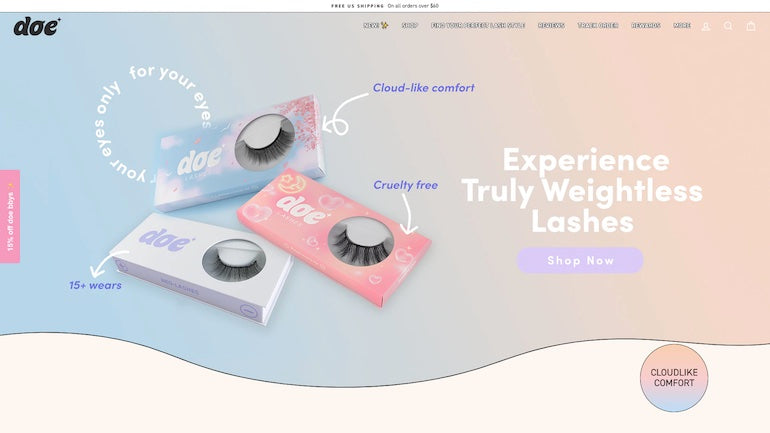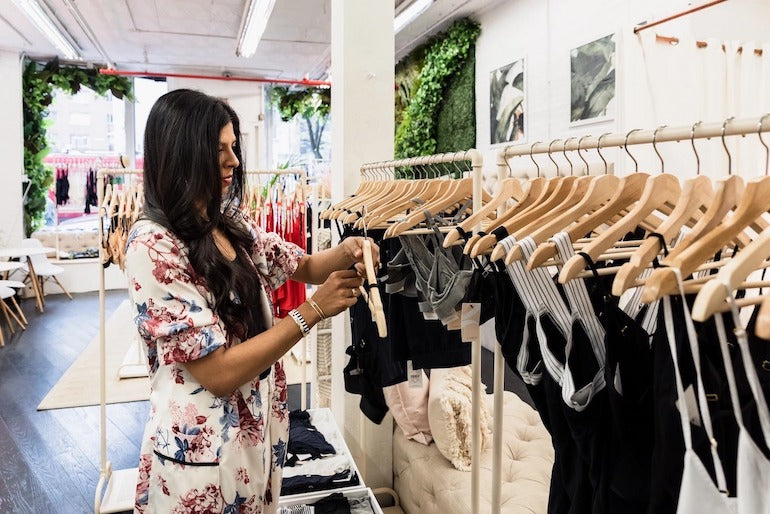A brand is about more than just the products a company sells. It's about every interaction a customer has with a company, and in 2022, delivering an outstanding customer experience is one of the main ways a business can differentiate itself.
As customer acquisition has become harder and advertising costs continue to climb, businesses need to create an enjoyable and memorable experience around their brand—whether online, in person, or a combination of both—to ensure customers want to come back again and again. Customer expectations over the last couple of years have risen significantly, and customers now expect to be able to order online but return in store, or look at a product in a showroom and buy online, for example.
To put it in perspective, 73 percent of consumers say that customer experience has a major impact on their purchasing decisions. That means almost three-quarters of shoppers would likely decide not to buy from a store (whether ecommerce or in person) that provides a poor experience.
For this article, we dove into Shopify’s Future of Commerce report and tapped a range of savvy Shopify Partners and insiders to explore how you can help merchants create a fantastic customer experience that stands out from the crowd.
Check out Commerce Trends 2023
The 2023 edition of Shopify’s annual report is now available. Learn about the latest trends shaping commerce, pulled from proprietary data, insider experts, and top global brands.
See reportTransactional commerce is a thing of the past
Ecommerce used to be a lot more transactional: Merchants created a product, put it on the internet, and somebody would find and buy it—most likely just once.
Now ecommerce is all about long-term relationships. We have the ability to gather a lot of insights about our customers and their buying behavior, and tracking that information is a critical part of creating an experience tailored to our customers.
“We’re in the early stages of moving from transactional to more contextual commerce,” Andrew Bialecki, founder ofKlaviyo, explains. “Transactional commerce tends to be pretty homogeneous. When you walk into a store, even if it's a huge big-box chain that has almost an infinite budget, they have no idea who you are and whether it’s your first or hundredth visit.”
Companies tried to create the best experience for everybody possible, but now customers have become accustomed to personalized ecommerce experiences. Today, they are increasingly looking for differentiated experiences and brands they can connect to that share their values.
Bialecki believes that building and owning direct customer relationships is really important. He advises to take advantage of the opportunity to ask consumers questions, collect information, and build more personalized, more contextualized experiences.
“Land the customer on a custom landing page, so that they immediately see the products they're looking for,” suggests Sharon Goldstein, CEO ofLimeSpot. “Personalize product recommendations to rapidly put the right products in front of customers and put them in context to what else they've been browsing or buying.”
Key techniques to create a great customer experience
Creating a memorable and seamless customer experience, whether online or in person, regardless of the channel, is essential to make shoppers happy. A smooth mobile performance is now a given, for example, as is a fast and painless checkout. Let’s take a look at some other ways you can achieve a fantastic customer experience.
Start with the basics
Interactivity and cutting-edge technology like AR, VR, and 3D media can take your customer experience to the next level, but it’s important not to get carried away. “Too many times brands get distracted by the bells and whistles, and they forget the basics,” says Chelsea Jones, founder ofChelsea & Rachel Co.
Before you explore new technology, ask yourself if the brand is servicing customers well, if they are getting their customers’ eyes on their products, and if customer service is already a priority.
The smaller the brand, the easier it is to excel at customer service. Consider investing in a customer service platform, such asGorgias, for example, and check essentials like the mobile experience
How you tell your story and what you stand for, while creating a consistent end-to-end customer experience, has become a critical differentiator. Wherever your audience happens to be, ensure the experience is consistent at every touchpoint in their journey. This might include replicating your website experience on social commerce channels to provide familiarity, for example.
You might also like: 10 Tips to Help Your Clients Handle Surging Customer Service Demand.

Build custom storefronts
It’s now easier than ever to build a unique shopping experience with custom storefronts, Shopify’s solution to going “headless.” Headless commerce separates your front-end storefronts from your back-end systems, which gives you total creative control.
Custom storefronts enable merchants to create virtual try-ons using AR, user-friendly product customization experiences to personalize the item they’re thinking of buying, or using gamification elements to make the checkout experience more fun, among other uses.
“Headless will continue to be a major player,” believes LimeSpot CEO Sharon Golstein. “The benefits are being able to separate the product catalog from the frontend experience, allowing brands to differentiate themselves by having a site experience that's not theme-based but truly looks like how they want it to be, and having the opportunity to update content in an easier, smoother, and more continuous way.”

Balance personalization and privacy
While personalization is now standard and customers want to feel known, they also have become more savvy and will only share their personal data if they trust a brand.
In fact, Shopify’s Future of Commerce report found that 46% of consumers say they're okay with brands they like using their personal information to deliver relevant content and offers. What’s more, consumers are over three times more likely to abandon brands that “over-personalize,” compared to brands that fail to personalize enough.
So be subtle and don’t include too much personal data in customized communication, or you risk scaring the customer away.
Create a community
To strengthen relationships with customers, many brands are turning to community building. Whether it’s through social commerce, adding a live chatroom to their proprietary site, or creating in-real-life experiences, communities foster brand awareness, loyalty, and retention. At the same time, communities lower customer support costs.
“Brands have a big opportunity to reach people in a much more authentic and interactive way now,” explains Yulie Kwon Kim, VP of Product Management at Facebook. “I'm really excited about live shopping, for example, because it marries the authenticity and the conversations that you would have in store, but brings them online in a rich way.”
The key is to not only create a space for customers to connect with the brand but also for fellow supporters to connect with each other. “You often see consumers talking to each other during live shopping events. They might say things like, ‘I actually bought this product two days ago, and it’s great,’ which builds trust and is also fun.”

Be as flexible as you can
Customer service is a major part of providing a positive customer experience, and one way to do that is by making the customer journey and buying process as safe, convenient, and flexible as possible.
According to research conducted for Shopify’s Future of Commerce report, 50% of consumers are more likely to order a product online if shipping is free, 33% if it’s fast, and 25% if it’s flexible. Nadine Iacocca, chief strategy and growth officer atStream Commerce, has learned—both pre-pandemic and now—that solutions and services need to be simple and flexible above all else.
“The consumer has a varying degree of needs,” she explains. “They are also demanding a much higher degree of services and customer experience online. So the solution needs to be simple as well as flexible, and how you deliver that is key.”
Flexibility takes many forms, and Iacocca recommends offering customers different options throughout the purchase journey, robust search and filters, and tools that predict the consumer’s needs or wants. Another way to offer flexibility is by using brick-and-mortar locations as fulfillment centers for blended shipping options like buy online, pick up in-store (BOPIS).
Communicate with transparency
Transparency is not only important in terms of privacy and security, it’s also an essential part of how you communicate shipping information.
Shopify’s Future of Commerce report found that 46% of shoppers are actively looking to shop from businesses that clearly show anticipated delivery times. And it’s not just the shipping per se that customers are interested in. They also want to know whether a brand is adopting sustainable business practices for the manufacturing and delivery/return of the product to reduce the impact on the planet.
It’s not surprising that 49% of the brands surveyed for the Future of Commerce report are investing in not just their delivery practices, but also in transparency with their delivery promises, like sharing when an order is prepared and shipped.
“A lot of merchants are starting to be more upfront about how exactly their product is made, how it’s shipped, and what the whole life cycle of the product looks like,” points out Michelle Tampoya, senior product marketing lead for shipping and money at Shopify. “Is the carbon being offset, for example, and is the merchant being clear to the consumer that they care about it as much as they do?”
So, establish open lines of communication, whether it’s through Instagram stories, blog posts, or email newsletters, to take consumers behind the scenes of your operation. Share why you make a product a certain way and how (fast) it’s going to be delivered. Chatbots are great but they should only be used to support the customer service team. It’s essential to have real people to proactively respond to—and resolve—issues like unexpected shipping delays.

Invest in a unique in-person experience
In-person shopping experiences now pose a huge opportunity, as customers missed out on them during the lockdowns of the COVID-19 pandemic so much.
To stay competitive, 40% of brands surveyed for Shopify’s Future of Commerce report said offering experiential retail would be a top priority for them in 2022, something 32% of consumers said they are likely to engage with.
Physical retail is making a resurgence, and many direct-to-consumer brands are investing in pop-up shops. As some consumers are still hesitant to go back to physical stores, however, creating an interesting and unique experience that’s different to the ecommerce offering is crucial to attract shoppers back in person.
“Nothing compares with walking into a physical store and being greeted by a great experience,” says Hilding Anderson, head of retail strategy at Publicis Sapient. “Even by 2023 and 2024, we're predicting that up to 80% of all revenues are going to come through the physical stores. They aren't going away, it's more about reimagining them. Can you get away with a smaller footprint store, for example? Can you do a pop-up store? Can you embed digital into those stores? It's really about thinking about it from the entire ecosystem for a retailer.”
Experiential retail experiences are especially suitable for more luxurious brands.
“People are going to want to be catered to with a white glove service,” points out Chelsea Jones. “That's something that ecommerce will always lack. Now that we can get anything at our fingertips on our phone, the retail space is going to be more experiential-led.”

Build a customer-centric strategy for long-term success
A lot of companies still put their own product or service first, not their customers. However, to really optimize engagement and boost sales, you need to create a truly customer-rather than product-centric experience.
“Businesses that not only own their customers and know who they are, but are speaking and listening to them, will have a definite advantage going forward,” points out Robert Befumo, head of ecommerce strategy and marketing at Parkfield Commerce.
The above tips are just a few suggestions to get you started on your journey to place your customers at the heart of everything. Carry out research involving real customers to explore what works best for the brands you’re working with, ensure the experience is consistent and seamless across the various channels you choose to interact on, and finetune it with attention to detail to foster long-term relationships with happy shoppers. These are surefire ways to discover the right path to great customer experiences.









